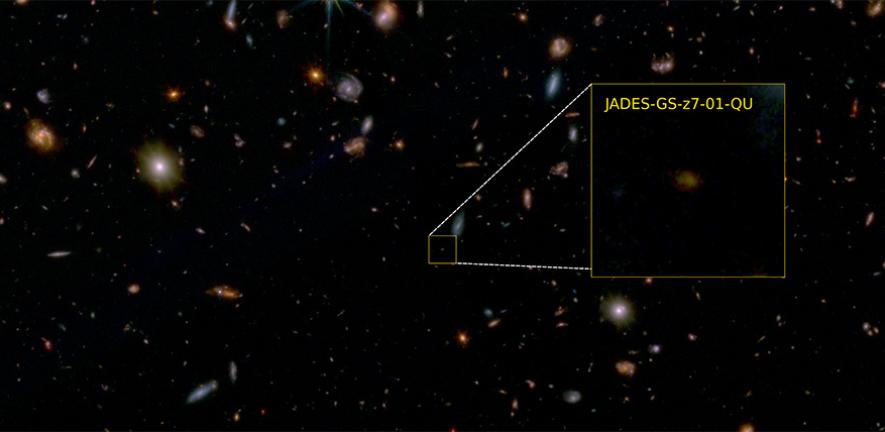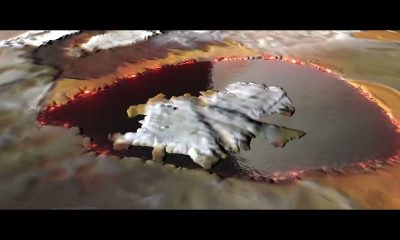News
This Galaxy Was Lifeless as Early as 700 Million Years After the Universe’s Birth

When a galaxy runs out of gas and dust, the process of star birth stops. That takes billions of years. But, there’s a galaxy out there that was already dead when the Universe was only 700 billion years old. What happened to it?
That’s what an international team of astronomers wants to know. “The first few hundred million years of the Universe was a very active phase, with lots of gas clouds collapsing to form new stars,” said Tobias Looser from the Kavli Institute for Cosmology at the University of Cambridge. “Galaxies need a rich supply of gas to form new stars, and the early universe was like an all-you-can-eat buffet.”
So, when the galaxy JADES-GS-z7-01-QU showed up in a JWST observation, it didn’t exhibit much evidence of ongoing star formation. (JADES stands for JWST Advanced Deep Extragalactic Survey.) It’s in what astronomers refer to as a “quenched” state and looks like star formation started and quickly stopped. Figuring out why this happened to the young galaxy is an important step in cosmology. Why did it stop creating stars? And, were the factors that affect star formation the same then as they are today?

(Credit : ESO/M Hayes)
When a Galaxy Stops Forming Stars
Star-formation quenching is something astronomers don’t expect to happen quickly. “It’s only later in the universe that we start to see galaxies stop forming stars, whether that’s due to a black hole or something else,” said Dr Francesco D’Eugenio, also from the Kavli Institute for Cosmology and a co-author with Looser on a recent paper about JADES-GS-z7-01-QU.
Star birth usually begins as clouds of gas coalesce together. Gas-rich regions, including galaxies, are prime spots for star-birth nurseries. JWST data about JADES-GS-z7-01-QU shows that this baby galaxy experienced a very intense period of star formation shortly after it began forming (after the Epoch of Reionization). For somewhere between 30 to 90 million years, it was ablaze with star formation. Then, suddenly, it stopped.
That’s not surprising—although astronomers aren’t sure why it stopped. Clearly, it ran out of gas. Maybe a supermassive black hole at its heart gobbled up much of the available “star stuff”. The black hole’s rapidly moving winds and jets could also have shoved a great deal of the star-birth material completely out of the galaxy. It’s also possible that the very rapid pace of star formation that JADES-GS-z7-01-QU experienced simply used up the supply. That’s not impossible, according to Looser. “Everything seems to happen faster and more dramatically in the early universe, and that might include galaxies moving from a star-forming phase to dormant or quenched,” he said.
Figuring out the Answer
It’s not clear from the current JWST data what happened to this little galaxy back at the dawn of time. Astronomers are still probing the data. “We’re not sure if any of those scenarios can explain what we’ve now seen with Webb,” said paper co-author Professor Roberto Maiolino. “Until now, to understand the early Universe, we’ve used models based on the modern universe. But now that we can see so much further back in time, and observe that the star formation was quenched so rapidly in this galaxy, models based on the modern universe may need to be revisited.”

That means more observations using JWST. “We’re looking for other galaxies like this one in the early universe, which will help us place some constraints on how and why galaxies stop forming new stars,” said D’Eugenio. “It could be the case that galaxies in the early universe ‘die’ and then burst back to life – we’ll need more observations to help us figure that out.”
There’s one other possibility that astronomers will want to probe. JADES-GS-z7-01-QU looked dead at the time of its life when JWST observed it. But, it’s possible that the star-birth quenching was only a temporary thing. Maybe it was caused by periodic outflows of star-stuff material to interstellar space (driven by the black hole in the nucleus). Other galaxies have also been observed to be taking a star-birth break, but they’re much more massive than this one.
Perhaps JADES-GS-z7-01-QU started up the star-forming factory later in its history. In that case, it could well have grown much more massive in later epochs of cosmic history. And, this provides an intriguing idea: perhaps other “quenched” galaxies also took a break, then got a massive infusion of gas—perhaps through collisions with other galaxies—to create later generations of stars. Future JWST observations should uncover more of these galaxies and that should allow astronomers to study their quenched phases in more detail.
For More Information
Astronomers Spot Oldest ‘Dead’ Galaxy Yet Observed
A Recently Quenched Galaxy 700 Million Years After the Big Bang
A Recently Quenched Galaxy 700 Million Years After the Big Bang (arXiv preprint)
News
University of Wisconsin-Milwaukee and Protesters reach an agreement to dismantle encampment

Protesters at the University of Wisconsin-Milwaukee have agreed to end their pro-Palestinian encampment following an agreement reached with the school, university officials announced on Sunday. The encampment, which had been in place for two weeks, will be dismantled by Tuesday, marking the end of what was believed to be the last standing encampment at a Wisconsin college.
University officials had allowed the encampment to remain on a patch of lawn between Mitchell Hall and a busy thoroughfare on the campus’s southern boundary, opting not to involve law enforcement. This approach differed from the response at the University of Wisconsin-Madison, where police were called in to remove tents after negotiations fell through. Despite initial efforts to disband the encampment, Wisconsin-Madison eventually reached an agreement with protesters to voluntarily dismantle the camp prior to commencement ceremonies.
Chancellor Mark Mone of Wisconsin-Milwaukee stated last Wednesday that the university had exhibited “the widest possible amount of patience and restraint.” However, he also cautioned that patience was wearing thin and hinted at potential action by the school. Following discussions with the UWM Popular University for Palestine Coalition, the university agreed to advocate for a cease-fire between Israel and Hamas, condemn the destruction of schools and universities in Gaza by Israeli forces, and hold meetings with protest leaders regarding university investments.
Additionally, the university pledged to urge the Water Council, a Milwaukee organization of water technology companies, to sever connections with two Israeli government-owned entities, Mekorot and the Israel Innovation Authority. Chancellor Mone serves as the treasurer on the Water Council’s board of directors.
In return for these commitments, the protesters agreed to dismantle the encampment beginning on Sunday and completing the process by Tuesday. They also agreed not to disrupt the university’s commencement ceremonies scheduled for Sunday. In a statement, the protesters expressed their satisfaction with the agreement, stating, “After hard fought edits and careful consideration by the coalition, we determined we had obtained all possible benefits from the encampment.”
The resolution of the encampment at the University of Wisconsin-Milwaukee represents a successful outcome of negotiations between university officials and protesters. By reaching a compromise that addresses the concerns of both parties, a peaceful resolution has been achieved, allowing for the encampment to be taken down without incident.





















